Les Arts d'Asie à l'honneur, le 12 décembre chez Christie's Paris
Lot 42. Rare et important paravent à douze feuilles en laque de Coromandel, Chine, Dynastie Qing, Epoque Kangxi, Daté de 1699. Estimation : €200,000-400,000. Price realised: EUR 2,110,000. © Christie’s images limited
Paris – Le 12 décembre prochain, le département d’Art d’Asie présentera sa seconde vente de l’année. Réunissant 238 lots pour une estimation globale comprise entre 5.1 et 7.6 millions d’euros, cette vente propose un éventail complet des arts décoratifs asiatiques présentant plusieurs objets à la rareté et à la provenance exceptionnelles.
Un des lots phares et tout à fait remarquables de la vente est un paravent en laque de Coromandel, composé de 12 feuilles, datant de l’époque Kangxi. Provenant d’une collection particulière française, acquis en 1967, publié et exposé de nombreuses fois, il a un intérêt historique majeur. On y voit l’île de Nan’ao au large des côtes chinoises en direction de Taiwan. Ce paravent a été offert au gouverneur de l’île, le général Zhou Hongsheng à l’occasion de son soixantième anniversaire. C’est un rarissime exemple de paravent faisant office de carte géographique où chaque nom de lieu est indiqué. Pouvant rappeler les paravents que collectionnait Coco Chanel, c’est une rare opportunité d’acquérir une pièce de cette taille, alliant technique et esthétique (estimation : €200,000-400,000).
Lot 42. Rare et important paravent à douze feuilles en laque de Coromandel, Chine, Dynastie Qing, Epoque Kangxi, Daté de 1699. Dimensions d'une feuille: 290 x 52 cm. (114 ¼ x 20 ½ in.). Largeur totale: circa 624 cm. (circa 246 in.). Estimation : €200,000-400,000. Price realised: EUR 2,110,000. © Christie’s images limited
Le recto représente la cité de Nan'ao (Nan Ngao) sur l'île de Shen Ao. Autour se presse une nombreuse flotte de guerre faite de diverses embarcations battant pavillon. On aperçoit aussi d'autres îles alentour dont l'île de Formose (Taïwan). Cette île d'une petite superficie est située dans la mer de Chine méridionale, tout près de l'île de Shantou (Swatow) sur la côte de la province maritime de Guangdong. La longue inscription au dos est datée de 1699 et a été rédigée par le lettré Zeng Huagai. Elle relate les hauts faits du général Zhou Hongsheng et les distinctions dont l'empereur Kangxi le gratifia. Zhou Hongsheng reçut ce paravent à l'occasion de son soixantième anniversaire.
Provenance: French private collection, acquired from Jean and Patrick Mahé, Paris, 1967.
Literature: Jardin des Arts, n°152-153, July-August 1967, pp. 110-111.
Jours de France, n° 783, 11 December 1969, pp. 140-141.
Annamaria Rispoli Fabris, L’arte della lacca, Electa Editrice, Milano, 1974, ill. 39-42, pp. 55-59.
Kangxi, Empereur de Chine, 1662-1722, La Cité interdite à Versailles, Musée national du chateau de Versailles, 27 January-9 May 2004, Paris 2004, n°175, p. 189.
Nicole Brugier, Les laques de Coromandel, La Bibliothèque des Arts, Lausanne, 2015, p. 127.
Exhibited: Kangxi, Empereur de Chine, 1662-1722 : la Cité interdite à Versailles, Musée national du chateau de Versailles, 27 January - 9 May 2004, cat. 175 (fig.3).
Note: See some other examples of highly important Kangxi period twelve-panel Coromandel screens of large size, sold in Christie's New York, 14-15 September 2017, lot 976, Christie's Hong Kong, 28 November 2012, lot 2037, Sotheby's London 8 November 2017, lot 38 and Sotheby's New York, 19 March 2014, lot 410. See a 'lanscape' Coromandel screen depicting the West Lake sold at Sotheby's Paris, 11 June 2019, lot 93.
Le département des Arts d’Asie est heureux de présenter cette année une belle section de peintures chinoises dont la collection de Zinovi Pechvoff, l’ancien ambassadeur de la France Libre en Chine. Lors de son séjour, il constitua une collection de peintures modernes chinoises comprenant des œuvres de Guan Shanyue, Li Xiongcai, Sun Zongwei, et Xu Beihong dont une encre représentant un Cheval, estimée €50,000-70,000. Deux autres œuvres, Owl and Sparrows de Li Xiongcai (estimé €25,000-35,000) et Tiger de Guan Shanyue (estimé €20,000-30,000) lui avaient été offerts par des hommes politiques chinois, attestant alors de son prestige au sein des cercles politico-culturels de Chongqing.

Lot 1. Guan Shanyue (1912-2000), Tiger. Monté en rouleau, encre et couleur sur papier. Signé avec un cachet de l'artiste. Etiquette inscrite par Guo Youshou (1901-1978), "Dédicacé à l'Ambassadeur général de France Zinovi Pechkoff, 6 décembre 1945 à Chengdu". Dimensions: 145,5 x 68,5 cm. (57 ¼ x 27 in.). Estimation : €20,000-30,000. Price realised EUR 40,000. © Christie’s images limited
Provenance: Gifted to the Free French Ambassador to the Republic of China, General Zinovi Pechkoff (1884-1966), by Guo Youshou (1901-1978) in Chengdu on 6 December 1945.
On mentionnera aussi une importante peinture de l’artiste Li Keran, évoquant un Paysage de Giulin, site sacré pour les chinois et grande source d’inspiration pour l’artiste. Les contrastes de formes et de noirs et blancs, rythmés par des zones de couleurs tendent à traduire l’atmosphère et l’âme du lieu faisant également écho à l’état d’esprit de l’artiste, (estimation : €200,000-300,000).
Lot 22. Li Keran (1907-1989), Paysage de Giulin. Monté, encre et couleur sur papier. Signé par l'artiste avec un cachet, daté de 1979. Dimensions: 69 x 96 cm. (27 ¼ x 37 ¾ in. ). Estimation : €200,000-300,000. Unsold. © Christie’s images limited.
Provenance: Acquired from Mr Chen Shuliang's (1901-1991) family member in the 2000s, by repute.
Note: Li Keran’s landscapes are never mere paintings from nature rooted in realism. He said, “In order to paint a good landscape, one must first grasp the soul of landscape painting—the artistic concept.” In other words, during the process of painting a scene from nature, he grasped the communion between the spirit of mountains and streams and the spirit of the artist. The artistic concept was manifested through the transformation of these spirits through his brush. This conforms to the traditional ideal of “For the exterior one learns from forms; for the interior the heart.”
Guilin—a favourite source of Li Keran’s inspirations—is a sacred site for Chinese landscape painting known for its unusual and stunning scenery. He loved Guilin’s natural beauty all his life: The Panorama of Li River hung in his studio for a long time for his enjoyment. Beginning in the spring of 1959 when he went to Guilin with the painter Yan Di, he journeyed there on several occasions. He went on a painting excursion in 1962 and filmed an art education video there in 1980. In Guilin Landscape, Li Keran used layers of contrasting ink—ranging from dark to light and vice versa—to visually build the volume of the rocky cliffs along the river. Strategically he also placed whites and blues to colour the houses and river, brightening the scene. While Li Keran applied saturated layers of dark ink, the overall image is nevertheless lively and highly defined.
Provenant de la collection d’Edith Desaleux, connue notamment pour avoir fait don au musée Cernuschi d’une Pieta de Lin Fengmian aujourd’hui une des œuvres phares du musée, les collectionneurs pourront acquérir une œuvre du même artiste, Deux femmes (€25,000-35,000), cadeau du peintre à la collectionneuse et mécène qui contribua à faire connaître en France d’importants artistes chinois, tels Zao Wou-Ki.
Parmi les objets d’art chinois, les spécialistes ont sélectionné de magnifiques laques, à l’instar d’une rare et importante boite en laque rouge, dont le couvercle est délicatement sculpté de fleurs de pivoine. Elle est estimée €80,000-120,000. Tout le raffinement et la poésie de l’art chinois s’expriment ici ainsi que dans une rare paire de boîtes impériales lobées très sophistiquées en laque rouge estimées €60,000-80,000.
Lot 62. Rare et importante boite couverte en laque rouge, Chine, Dynastie Ming, marque incisée à six caractères et époque Xuande (1426-1435). Diamètre: 22 cm. (8 ¾ in.) Hauteur: 8,2 cm. (3 ¼ in.) Estimation : €80,000-120,000. Price realised: EUR 150,000. © Christie’s images limited
Provenance: Previously in an important private collection.
Nagel auction, 6 May 2011, lot 22.
Note: The floral designs on early Ming lacquer boxes represent some of the finest decoration found in the Chinese decorative repertoire, as evident in the exquisite carving on the present box. Several boxes carved with this design of peony blossoms are known in various sizes, a few of large size (30 cm. diam. upwards) with five peonies and several of smaller size (approx. 15 cm. diam.) carved with one to three peonies. It appears that boxes of mid-size, as is the case with the present lot, are rarer.
A box of the same size and with a very similar configuration is illustrated in Zhongguo Qiqi Quanji, vol. 5, Beijing, 1995, no. 18; while another of slightly larger size (25 cm. diam.) is illustrated ibid., no. 8. See a 'three peony' box and cover with a carved Xuande mark, in the collection of the Tokyo National Museum, illustrated inToyo no Shikko-gei, 1977, cat. No. 505.
Compare also the style of decoration on two large peony boxes with incised Yongle marks, one sold in our London Rooms, 5 June 1995, lot 16, and the other sold in these Rooms, An Important Collection of Chinese Lacquer, 30 April 2001, lot 637. Dishes with similar design are also known, such as the two in the Nezu Museum, Nezu Bijutsukan, Mei hin shusei, 1986, nos. 491-492.
Mentionnons également un rare pot à pinceaux en jade épinard entièrement sculpté, portant une rare marque de l’empereur vietnamien Minh Mang (1791-1841), (estimation : €150,000-250,000). Signalons aussi un brûle-parfum parfum impérial d’une grande rareté en émaux cloisonnés d’époque Qianlong (1736-1795) resté dans la même famille depuis trois générations dont les émaux imitent la patine aux oxydations aux nuances de vert, rouge, bleu des bronzes archaïques (estimation : €50,000-70,000).
Lot 128 - Pot pinceaux en jade vert épinard, Chine,dynastie Qing, 18-19e siècle. Estimation €150,000-250,000. Price realised EUR 175,000. © Christie’s images limited
CCf. my post: Rare pot à pinceaux en jade vert épinard, Chine, Dynastie Qing, XVIIIème siècle, inscription Minh Mang (1820-1841)
Lot 94. Brûle-parfum parfum impérial en émaux cloisonnés d’époque Qianlong (1736-1795). Hauteur: 68 cm. (26 ¾ in.), diamètre: 47,5 cm. (18 ½ in.). Estimation €50,000-70,000. Price realised EUR 225,000. © Christie’s images limited
La panse circulaire reposant sur trois pieds massifs légèrement cabriolets surgissant de trois gueules menaçantes d'animaux fabuleux en bronze doré. La panse et le couvercle ornés de masques de taotie et autres motifs géométriques archaïsants sur un fond vert foncé avec des tâches bleu et rouge imitant la patine et les oxydations des bronzes archaïques. La prise du couvercle en bronze doré est ajourée et finement sculptée d'un dragon à la poursuite de la perle enflammée dans des nuages stylisés, la base de la prise soulignée d'une frise de pétales finement ciselés.
Provenance: Previously in a Belgian private collection.
Note: This imposing tripod censer with its archaistic bronze-style decoration and enamel coloured to suggest the patina of ancient bronze represents a major artistic theme of the Qianlong reign.
Censers of this type might have been used for ritual purposes in the Qing court and would have normally been one of the five pieces of an altar set, which also includes two candlesticks and two flower vases. The Qianlong Emperor was a devotee of Tibetan Buddhism and had commissioned the construction of numerous Buddhist temples and shrines in Beijing and in other areas, each requiring an extensive array of ritual objects like the current censer. Furthermore, cloisonné enamel censers were used for display in the Qing court. The Qianqing gong, Hall of Heavenly Purity, for example, has a set of cloisonné enamel censers decorated with lotus blooms displayed in front of the Emperor’s throne.
The current censer is very similar in design and form to a number of pieces from the Qing Court Collection. See for example censers decorated with lotus scrolls, including: a censer of smaller size, lion masks, and a Qianlong mark but without a lid in the Palace Museum Collection, Beijing, illustrated by P. Berger, China: The Three Emperors 1662-1795, London, 2006. p. 139, no. 44; another similar piece also in the Palace Museum Collection, Beijing, illustrated in Metal-bodied Enamel Ware, The Complete Collection of Treasures of the Palace Museum, Hong Kong, 2002, p. 144, no. 138; and a censer illustrated in Sir H. Garner, Chinese and Japanese Cloisonné Enamels, London, 1970, p. 92, pl. 70.
See a cloisonne enamel archaistic you vessel with the same dark green colour imitating the archaic bronzes, bearing similar taotie decoration, in the Qing court collection, illustrated in Metal-bodied Enamel Ware, The Complete Collection of Treasures of the Palace Museum, Hong Kong, 2002, p. 155, pl. 147. See another Hu-shaped vessel with blue and green stains imitating traces of oxydation on archaic bronzes, also in the collection of the Palace Museum, Beijing (inventory number Gu00117113). It is interesting to notice that there are also a limited number of archaistic painted enamel vessels bearing the same colour scheme, see a painted enamel bronze tripod Yan-shaped censer, in the collection of the Palace Museum, Beijing (inventory number Gu00117067).
Mentionnons également un très rare autel de Cakrasamvara en argent partiellement doré, Chine, XVIIe siècle et un vajra chinois tout à fait extraordinaire, datant de la dynastie Yuan, chacun estimé €100,000-150,000 issus de la même collection particulière du sud-est asiatique.
Lot 202. Rare autel de Cakrasamvara en argent partiellement doré, Chine, Dynastie Qing, 18ème siècle. Hauteur de la statue: 15 cm. (5 in.), Hauteur de l'autel: 18 cm. (7 1/8 in.). Estimation €100,000-150,000. Unsold. © Christie’s images limited.
Il est représenté en alidhasana piétinant des divinités placées sur une base. Il enlace sa parèdre Vajravarahi, ses mains principales tiennent le vajra et la ghanta. Ses autres bras rayonnent autour de lui et tiennent divers attributs. L'autel ouvre à deux battants et repose sur une double base rehaussée de pétales de lotus. Les portes sont ornées de divinités et de rinceaux feuillagés. Des reliques sont conservées dans la base de l'autel.
Provenance: Sotheby's New York, 20 September 1985, lot 32.
American private Collection.
Bonham's New York, 16 March 2015, lot 53.
Note: This silver sacred image depicts the four-faced and twelve-armed Cakrasamvara embracing his consort Vajravarahi. They represent, respectively, compassion and wisdom and its union leads to enlightenment and Buddhahood. His name can be interpreted as one of ‘joined to the wheel of wisdom and bliss’. One of his distinctive attributes, the elephant-skin and symbol of illusion is stretched across his shoulders and held by the upper hands. His principle hands demonstrate the vajra and ghanta, symbolizing the transcending of duality culminating in enlightenment. The couple is trampling upon the Hindu gods Bhairava and Kalaratri as symbol of the superiority of Buddhism over Hinduism.
The artist cast this figure with an almost electrifying intensity radiating from the central face of the deity. The eyebrows is knitted in anger; his open mouth with fangs and still his face does not show bulging eyes and gaping jaw as is typical for wrathful deities. His emotionless facial expression is one between peace and wrath, while reflecting at the same time his impersonality of being a yidam or ‘pure appearance’ who transcendent duality.
Cakrasamvara and his consort are placed in a parcel-gilt silver shrine (gahu) which was a tradition within the Tibetan Buddhist culture. The fact that the present shrine is closed and does not show a window to reveal the deity inside most likely demonstrates that it was supposed to stand on a private altar. Some relics are kept in the base of the shrine. Most likely this high quality shrine and figure were made in one of the major workshops in China as present for an important Lama. Compare to another silver figure, though presenting Hevajra, sold in Christie's Paris, 12 December 2018, lot 29.
Lot 203. Rare et important vajra en bronze, dynastie Yuan (1279-1368).Longueur: 26,5 cm. (10 ½ in.). Estimation €120,000-180,000. Unsold.© Christie’s images limited.
La partie centrale est finement ornée de quatre pivoines épanouies, les deux côtés flanqués par quatre têtes alternant des expressions féroces et méditatives, symbolisant ainsi les huit gardiens de la foi bouddhique. Les extrêmités sont à décor ajouré, formées par huit piliers constitués d'un phénix et d'un dragon, le pillier central est rehaussé du neuvième dragon à quatre griffes au corps noueux, les deux prises en forme de perle sacrée émergeant d'une fleur de lotus.
Provenance: Previously from the Collection of the painters André Lemaître (1909-1995) and Yvanna Lemaître (1893-1973), France.
French private collection, acquired on the French art market on 22 February 1995.
Note: The Sanskrit word vajra or dorje in Tibetan is used both for the thunderbolt weapon of the ancient Vedic god Indra and the diamond, as symbol for its indestructible character. Due to its adamantine nature the vajra was chosen to stand for the final system of Buddhist thought, better known as Vajrayana. Buddha is also seated in the vajrasana or diamond posture. Since then it has remained the symbol par excellence of this esoteric school of religion. It is in fact one of the most important obligatory implements for rituals. Further, one can observe the vajra in the hands of protective gods as weapon of destruction of both internal and external enemies. As divine attribute it is used in worship by lama’s. During specific rituals the vajra is combined with the priest-bell or ghanta symbolizing respectively compassion and wisdom or ’means’ and ‘insight’. Thus the use of the two together stand for transcending duality resulting in enlightenment, the ultimate goal of every Buddhist student.
The extremely fine and complicated casting of the presented vajra in various sections and then joined together is a tour de force of Chinese craftsmanship. It combines the original Indic iconography transmitted to Tibet with Chinese symbols and design. It was during the Yuan period (1279-1368 AD) that their rulers took over this Vajrayana form of Buddhism as their state religion. As consequence ritual implements, sculptures and paintings were introduced in China and adapted to their own taste. This can be well gleaned from the presented rare vajra. Its centre is showing peony flowers flanked to both sides by each four heads, symbolizing together the eight guardians of the Buddhist faith. The latter heads are cast alternating with a ferocious facial expression topped by flaming hair-dresses and a more friendly expression continuing in chignons. It is interesting that a ferocious face is placed opposite a friendly one symbolizing the transcending of duality. All faces seem to be based on examples of the Chinese Song style. The eight curved prongs standing for the eight wind-directions are delicately modelled in the form of phoenixes which tails are issuing kui dragons chasing the pearl-finial placed on a lotus-flower, all stemming from a long-standing Confucianist tradition.
Very few similar vajras are recorded, all of the same size. One is published in Hugo Kreijger, Godenbeelden uit Tibet, SDU Uitgeverij, The Hague 1989, p. 121. Another one is discussed by Marcel Nies in Immortal Image, Antwerp 2001, pp. 34 and 35.
Un remarquable exemple de mobilier Ming est cette très belle table en bois rare et précieux huanghuali, exceptionnelle par sa taille et sa finesse d’exécution (estimation €200,000-400,000).
Lot 32. Rare et importante table d'autel en huanghuali, qiaotou'an, dynastie Ming (1368-1644). Hauteur: 95,5 cm. (37 5/8 in.) ; Longueur: 266 cm. (104 ¾ in.) ; Profondeur: 39 cm. (15 3/8 in.). Estimation €350,000-550,000. Price realised: EUR 237,500. © Christie’s images limited
Le long plateau aux extrémités évasées repose élégamment sur un bandeau sculpté en bas-relief de dragons archaïsants confrontés. Les deux pieds rectangulaires légèrement évasés en partie basse sont rehaussés d'un décor ajouré de dragons volant parmi des rinceaux feuillagés.
Provenance: With Compagnie de la Chine et des Indes, Paris, in the 1980s.
The current table is a remarkable example of late Ming furniture, not only because of the fine and precise workmanship, but also due to its perfectly balanced dimensions and fine timber used in its construction.
Various examples of similar tables are published, where the openwork panels at the ends are very finely carved with dragons, phonenix and other mythical creatures. See for example a jichimu qiaotouan formerly from the Museum of Classical Chinese Furniture Collection illustrated in Wang Shixiang et al., Masterpieces from the Museum of Classical Chinese Furniture, Hong Kong, 1995, pp. 112-3, no. 53, and sold at Christie's New York, 19 September 1996, lot 59; and again at Sotheby's New York, 14 September 2011, lot 126. Compare also a qiaotouan with phoenix spandrels exhibited in at the Hong Kong Museum of Art, In Pursuit of Antiquities, Thirty Fifth Anniversary Exhibition of the Min Chiu Society, Hong Kong, 1995, illustrated in the Catalogue, no. 242; and a pingtoauan with phoenix spandrels illustrated by G. Wu Bruce, A Choice Collection, Chinese Ming Furniture, Hong Kong, 2011, pp. 98-99. A huanghuali table in the Minneapolis Institute of Arts with more elaborately carved phoenix spandrels is illustrated by R. Jacobsen and N. Grindley in Classical Chinese Furniture in the Minneapolis Institute of Arts, Minneapolis, 1999, no. 42.
Refer to S. Handler's article, "Side Tables, a Surface for Treasures and the Gods," in Chinese Furniture: Selected Articles from Orientations, 1984-1999, Hong Kong, 1999, pp. 200-9, where she discusses the role of this type of table, both as a side table as well as a domestic altar table.
Les amateurs de sculpture auront l’opportunité d’acquérir deux belles statues en fonte de fer provenant de la collection Vérité. La première datant du XVe siècle, une statue de Juge de l’enfer, est le pendant de celle exposée au musée Guimet, (estimation : €20,000- 30,000). La deuxième est une grande statue de Luohan, estimé €40,000-50,000. On mentionnera également une petite statuette Song ayant appartenu au peintre suédois Einar Jolin. Fortement impressionné lors d’une visite au musée Guimet, on retrouve des objets d’art asiatiques dans ses peintures, à l’instar de cette statuette dans l’œuvre Blomor I vas (1951), estimation : €10,000-15,000. Une importante statue d’Amitayus en bronze d’époque Ming est également un de nos lots phares. Parfait exemple du style Yongle et Xuande, le traitement des bijoux et des rubans de cette statue en font une pièce d’une incroyable finesse, (estimation : €150,000-250,000, ill. à droite).
Lot 181. Ancienne collection Vérité. Grande statue de luohan en fonte de fer, Chine, Dynastie Ming, Epoque Jiajing (1521-1567), datée 1524. Hauteur: 79 cm. (31 in.). Estimation €20,000-30,000. Unsold. © Christie’s images limited
Il est représenté assis sur un socle quadripode (l'un des pieds endommagé), vêtu d'une ample robe monastique. Ses mains reposent sur son genou gauche et portent un petit bol à offrande. Un dragon émerge des plis de son vêtement, la tête et une griffe de l'animal apparaissent sous son bras gauche et la queue, le long de sa main droite. Le visage agrémenté de sourcils broussailleux et d'une épaisse moustache est empreint d'une expression sereine et profonde. L'inscription - au bas du dos - peut se traduire par : "Le moine Zhenci (Vraie-Compassion), du temple du Ciel-pacifié, à Pékin, et le bienfaiteur Niu Rui ont fait fondre cette statue au premier mois du troisième année de l'ère Jiajing (1524)", restauration au cou.
Provenance: French private collection.
Collection Vérité, Hôtel Drouot, Enchères Rive Gauche, Paris, 18 October 2009, lot 51.
Note: The cast inscription at the reverse is naming the temple or hall for which the figure was commissioned, as well as the donor. The date reads 'first month, third year of the Jiajing reign' (1524).
Evidence of the making of ironware in China is recorded as far back as the Shang Dynasty and techniques for making cast-iron tools, agricultural equipment, religious objects and weaponry became more and more sophisticated throughout the ages. By the Song Dynasty, when an "inner moulding" technique was developed, involving the insertion of clay or plaster into the mould, it became possible to make large cast-iron figures, which by the Ming Dynasty were made with great attention to details. For another important cast-iron figure of seated Luohan see Christie's London, 19 June 2001, lot 114.
Lot 208. Importante statue d’Amitayus en bronze, Chine, Dynastie Ming, XVème siècle. Hauteur: 37,5 cm. (14 ¾ in.). Estimation €150,000-250,000. Unsold. © Christie’s images limited
Il est représenté assis en vajrasana sur une socle lotiforme. Ses mains reposent sur ses cuisses en dhyanamudra. Il est paré de bijoux et vêtu d'un dhoti, un châle sur ses épaules. Son visage est empreint de sérénité. Ses cheveux sont ceints d'une couronne ; petite restauration, traces de dorure, non scellée.
Provenance: German private collection, 1980s, by repute.
Christie's New York, 21 March 2012, lot 796.
Property of a Southeast Asian collector.
Note: This finely cast sculpture can be regarded as a protype for Yongle and Xuande period sculpture in the Tibeto-Chinese style. His facial expression as well the treatment of the jewelry and streaming ribbons are characteristic features of bronze sculpture of the period.
Enfin, évoquons un rare thangka tibétain représentant Caturmuka Mahakala datant du XVème siècle et provenant d’une collection particulière d’Asie du Sud-Est, estimé entre 75,000 et 95,000 euros. Ce très beau thangka représente l’une des divinités les plus importantes dans la tradition Sakya du Bouddhisme tibétain. Ici, les cinq formes de cette divinité y sont représentées. Cette œuvre semble avoir été peinte peu après la mort de Khedrubje Geleg Palzang (1385-1438), étudiant de Tsongkhapa, un des grands précepteurs du bouddhisme tibétain.
Lot 214. Rare thangka représentant Caturmuka Mahakala, Tibet, XVème siècle. Dimensions de la peinture: 52 x 47,7 cm. (20 ½ x 18 ¾ in.), encadré sous verre. Estimation €75,000-95,000. Unsold. © Christie’s images limited
Il est représenté en pratyalidhasana piétinant des divinités placées sur une base lotiforme. Il tient dans ses mains principales le karttrika et le kapala. Ses deux autres mains portent le khadga et le trishula. Il est vêtu d'une peau de tigre. Il est paré de bijoux et d'un mala de têtes coupées. Ses quatres visages sont empreints d'une expression féroce.
Provenance: Christie's New York, 21 March 2012, lot 771.
Property of a Southeast Asian collector.
Note: The central deity, Chaturmukha Mahakala ("Four-faced Mahakala"), is the second of the principle protector deities in the Sakya tradition of Tibetan Buddhism. There are five forms of Chaturmukha Mahakala, and this painting depicts all of them. With the white and red faces on either side of the central blue face, the central deity can be identified as the Accomplishment form of Chaturmukha Mahakala. The diminutive Approximation form with green faces is located to the right of the central figure's head, while the Demon Faces form with the elephant and lion faces is located to the right of the trident. The other two forms, Performing Activities and Four Families, are at bottom center and bottom left, respectively.
Because most of the lineage teachers can be identified, it is possible to roughly date the age of the painting. As Khedrubje Geleg Palzang (1385-1438), student of Tsongkhapa, is located towards the end of the lineage without subsequent teachers after him, it can be assumed that this painting dates from not long after his death.
Vente: Le jeudi 12 décembre à 10h30 et 14h30 Exposition: Du samedi 7 décembre au mercredi 11 décembre, 10h-18h (dimanche 14h-18h)

/https%3A%2F%2Fprofilepics.canalblog.com%2Fprofilepics%2F1%2F0%2F100183.jpg)
/https%3A%2F%2Fstorage.canalblog.com%2F03%2F02%2F119589%2F96711876_o.jpg)
/https%3A%2F%2Fstorage.canalblog.com%2F11%2F31%2F119589%2F94773502_o.jpg)
/https%3A%2F%2Fstorage.canalblog.com%2F20%2F83%2F119589%2F94772815_o.jpg)
/https%3A%2F%2Fstorage.canalblog.com%2F26%2F72%2F119589%2F75604929_o.jpg)
/https%3A%2F%2Fstorage.canalblog.com%2F59%2F60%2F119589%2F26458628_o.jpg)
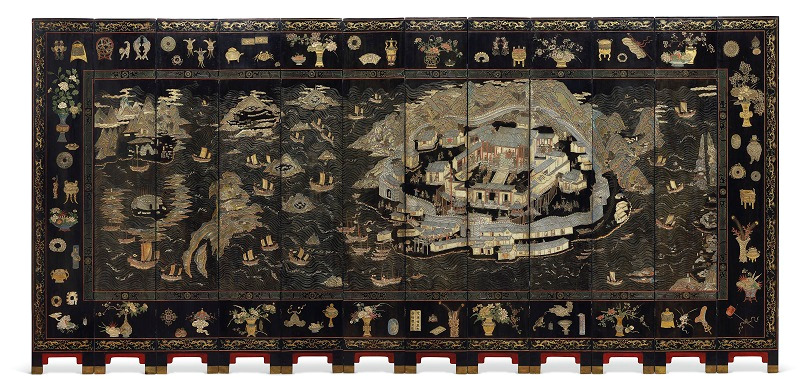
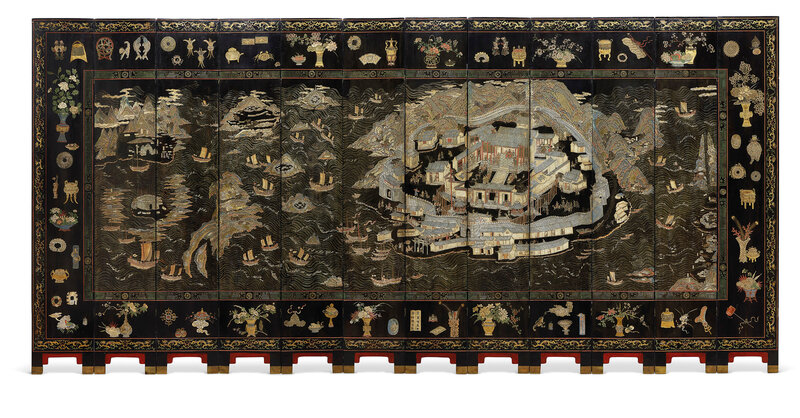




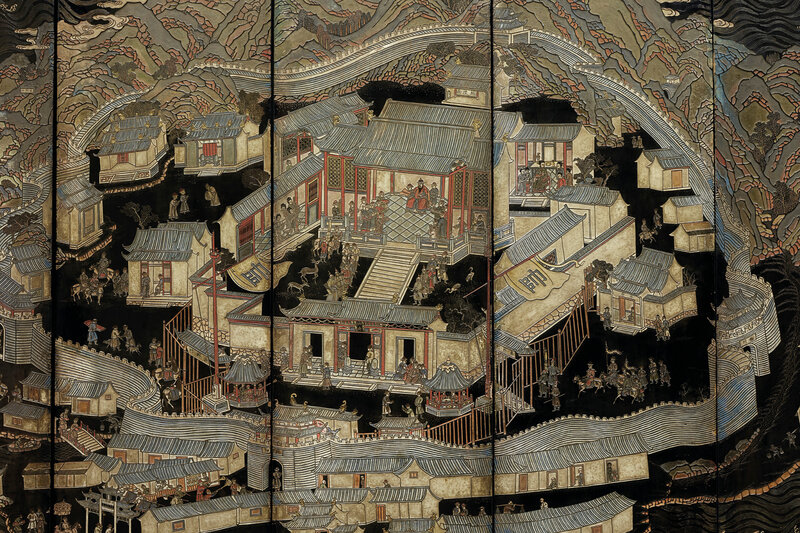












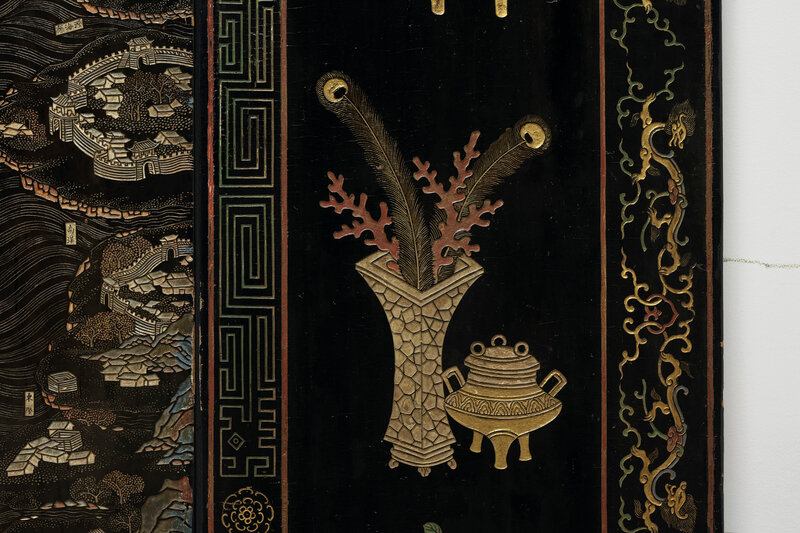


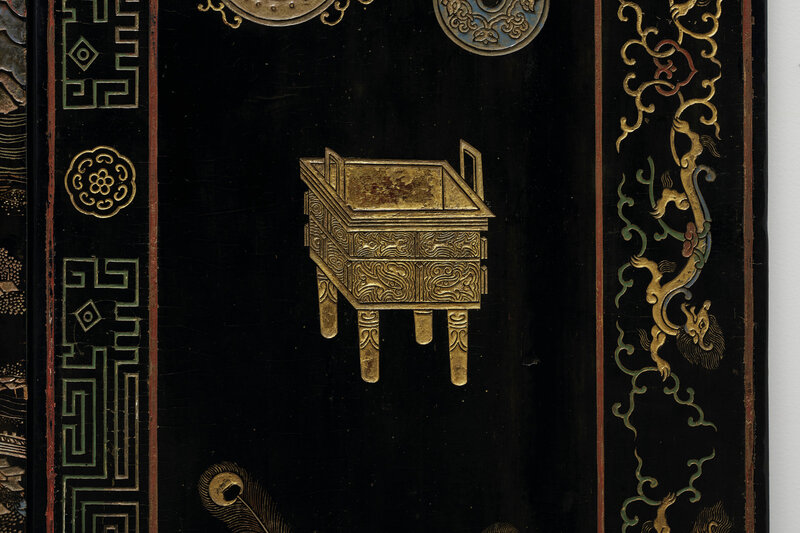













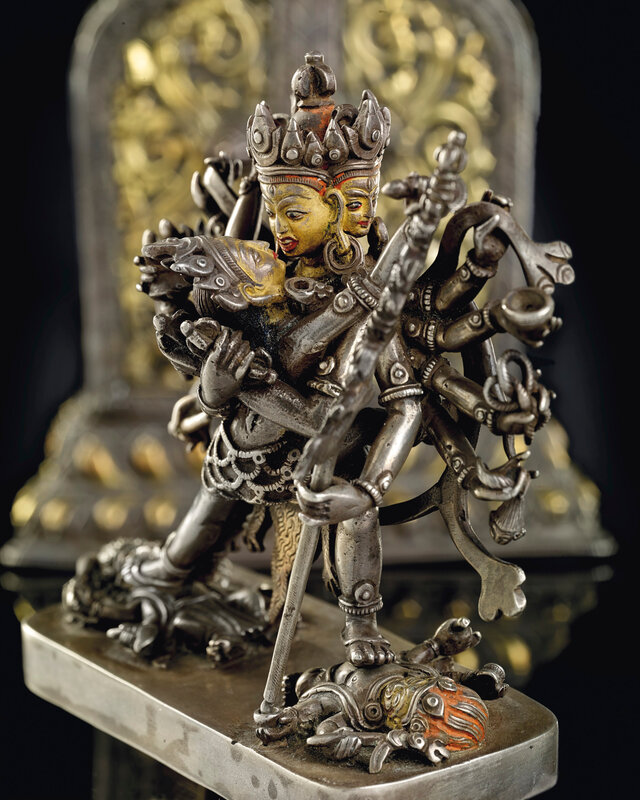
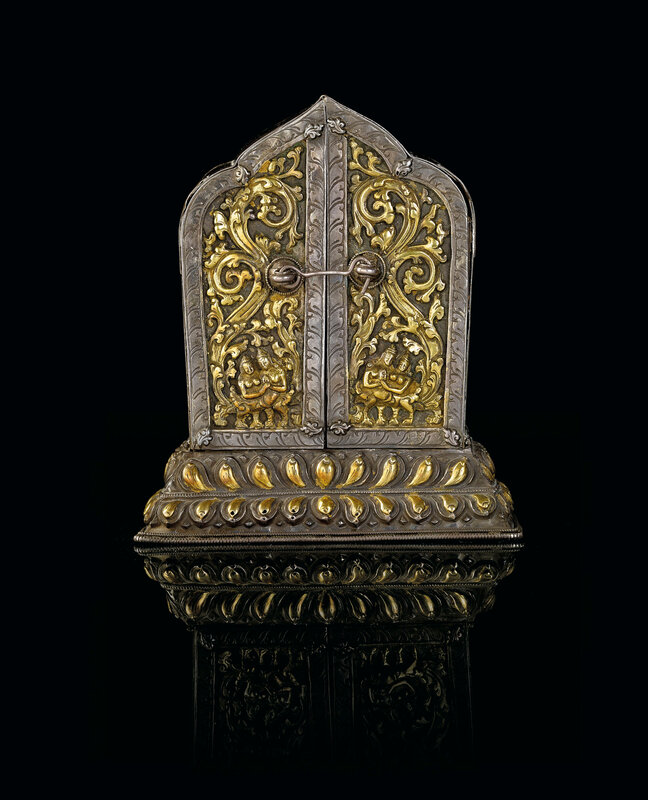








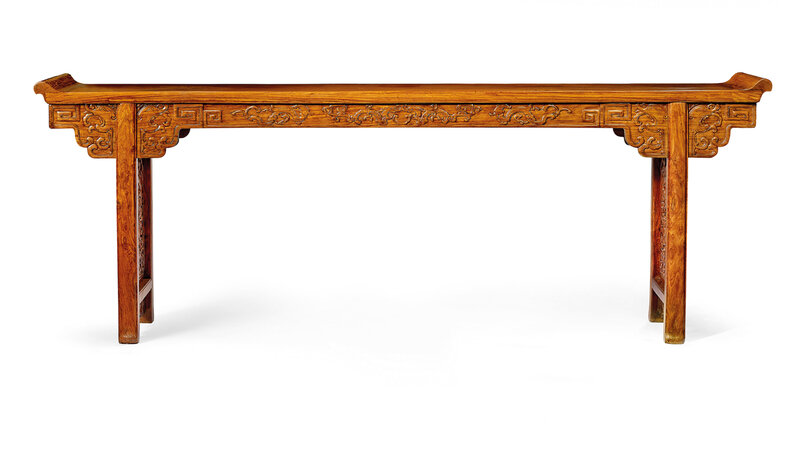

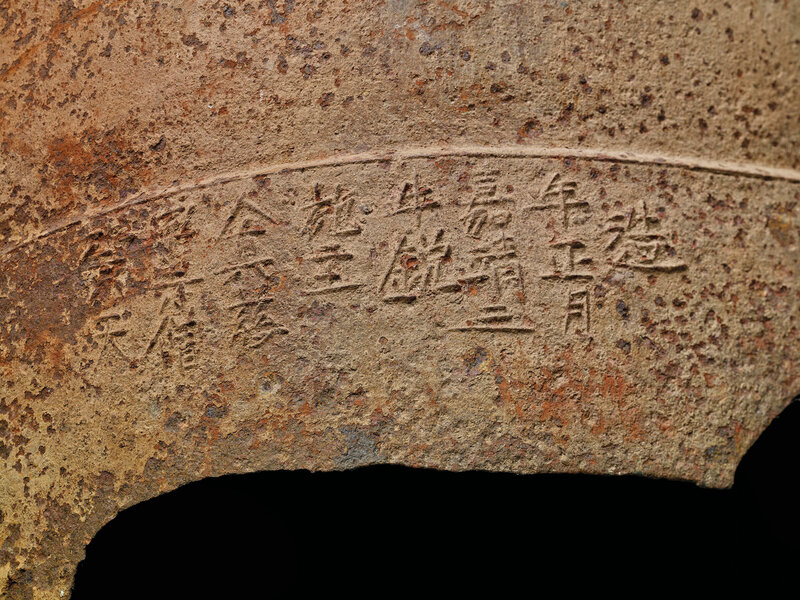
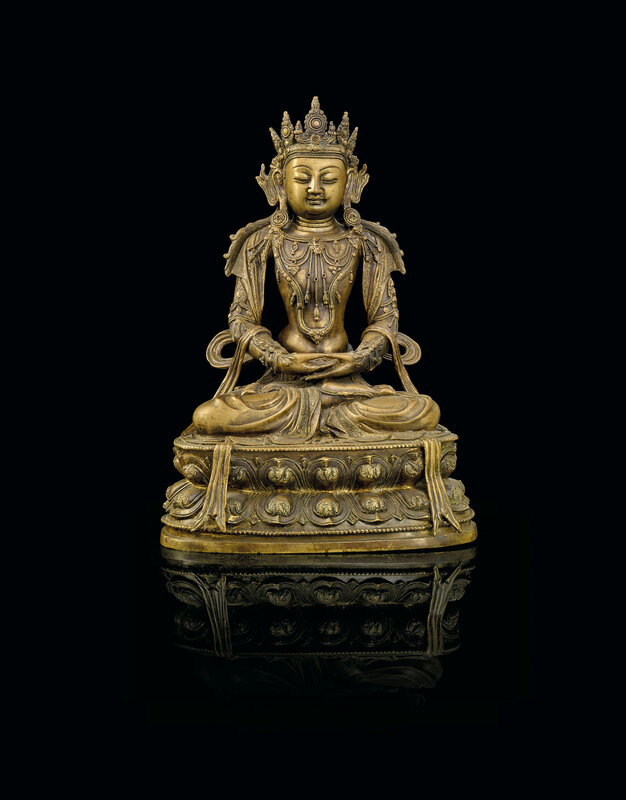





/http%3A%2F%2Fstorage.canalblog.com%2F20%2F60%2F119589%2F112503876_o.jpg)
/http%3A%2F%2Fstorage.canalblog.com%2F41%2F11%2F119589%2F111349003_o.jpg)
/http%3A%2F%2Fstorage.canalblog.com%2F49%2F34%2F119589%2F111348728_o.jpg)
/http%3A%2F%2Fstorage.canalblog.com%2F90%2F72%2F119589%2F111345790_o.jpg)